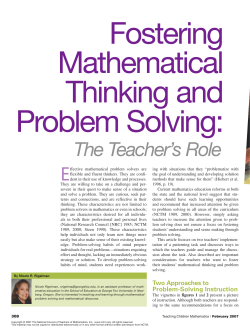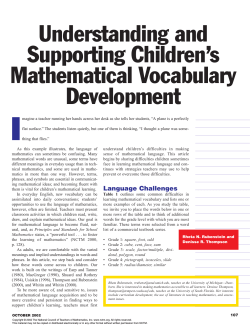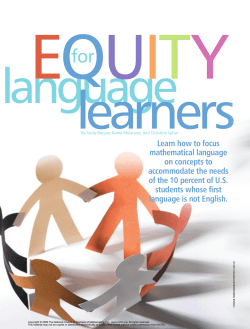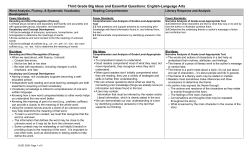
ds Standar P Developing
Principles and Standards Susan Jo Russell Developing Computational Fluency with Whole Numbers rinciples and Standards for School Mathematics (NCTM 2000) emphasizes the goal of computational fluency for all students. It articulates expectations regarding fluency with basic number combinations and the importance of computational facility grounded in understanding (see a summary of key messages regarding computation in Principles and Standards in the sidebar on page 156). Building on the Curriculum and Evaluation Standards for School Mathematics (NCTM 1989) and benefiting from a decade of research and practice, Principles and Standards articulates the need for students to develop procedural competence within a school mathematics program that emphasizes mathematical reasoning and problem solving. In fact, learning about whole-number computation is a key context for learning to reason about the baseten number system and the operations of addition, subtraction, multiplication, and division. P Susan Jo Russell, susan_jo_russell@terc.edu, is with the Education Research Collaborative, TERC, Cambridge, MA 02140. Her work focuses on developing curricula for elementary students and materials that support the professional development of elementary teachers. Edited by Jeane Joyner, jjoyner@dpi.state.nc.us, Department of Public Instruction, Raleigh, NC 27601, and Barbara Reys, reysb@missouri.edu, University of Missouri, Columbia, MO 65211. This department is designed to give teachers information and ideas for using the NCTM’s Principles and Standards for School Mathematics (2000). Readers are encouraged to share their experiences related to the Standards with Teaching Children Mathematics. Please send manuscripts to “Principles and Standards,” TCM, 1906 Association Drive, Reston, VA 20191-9988. 154 What Is Computational Fluency? Fluency, as used in Principles and Standards, includes three ideas: efficiency, accuracy, and flexibility. • Efficiency implies that the student does not get bogged down in many steps or lose track of the logic of the strategy. An efficient strategy is one that the student can carry out easily, keeping track of subproblems and making use of intermediate results to solve the problem. • Accuracy depends on several aspects of the problem-solving process, among them, careful recording, the knowledge of basic number combinations and other important number relationships, and concern for double-checking results. • Flexibility requires the knowledge of more than one approach to solving a particular kind of problem. Students need to be flexible to be able to choose an appropriate strategy for the problem at hand and also to use one method to solve a problem and another method to double-check the results. Fluency demands more of students than memorizing a single procedure does. Fluency rests on a well-built mathematical foundation with three parts: 1. An understanding of the meaning of the operations and their relationships to each other—for example, the inverse relationship between multiplication and division 2. The knowledge of a large repertoire of number relationships, including the addition and multiTEACHING CHILDREN MATHEMATICS Copyright © 2000 The National Council of Teachers of Mathematics, Inc. www.nctm.org. All rights reserved. This material may not be copied or distributed electronically or in any other format without written permission from NCTM. plication “facts,” as well as other relationships, such as how 4 × 5 is related to 4 × 50 3. A thorough understanding of the base-ten number system, how numbers are structured in this system, and how the place value system of numbers behaves in different operations—for example, that 24 + 10 = 34 or that 24 × 10 = 240 The third element listed previously—flexibility—is a key indicator of students’ command of this mathematical foundation. For example, the following three problems appear to be quite similar: 673 – 484 673 – 473 112 + 40 512 She called me over because the answer did not seem right to her, but she knew she had done the steps correctly. I said, “What if the problem was 110 plus 40? Try to figure that out in your head.” She started at 110 and counted on by tens (120, 130, 140, 150). Then she knew that she needed to add on the 2 and solved the problem easily. In another third-grade class, David solved a multiplication problem like this: 673 – 492 2 However, a fluent student or adult might solve each of these problems differently. Suppose that my basic way of solving most subtraction problems is by adding up. I might solve the first problem by thinking, “It’s 16 from 484 to 500, a hundred from 500 to 600, then another 73; so 100 plus 16 plus 73 is 189.” Any computationally fluent student or adult should solve the second problem by simply noting the relationship between the two numbers—that they have a difference of 200 between them. Adding up (or using any number of other subtraction algorithms) is not necessary if the solver understands the relationships of numbers in the base-ten system. The third problem could be solved by the adding-up method (as well as by other basic subtraction algorithms), but a person who is used to looking at the whole problem and drawing on knowledge about number and operation might very well notice that 492 is quite close to 500. By adding 8 to each number in the problem, the difference is maintained and the equivalent problem, 681 – 500, is easily solved. In her study of Chinese and American teaching of elementary mathematics, Ma (1999, p. 112) says the following: Being able to calculate in multiple ways means that one has transcended the formality of the algorithm and reached the essence of the numerical operations—the underlying mathematical ideas and principles. The reason that one problem can be solved in multiple ways is that mathematics does not consist of isolated rules, but connected ideas. Being able to and tending to solve a problem in more than one way, therefore, reveals the ability and the predilection to make connections between and among mathematical areas and topics. Connecting Understanding and Procedures Recently, during a visit to a third-grade classroom, I watched Eleana adding 112 and 40. She had written the numbers as shown, misaligning the columns: NOVEMBER 2000 57 ×4 288 He multiplied the 7 and 4, getting 28; put down the 8 and “carried” the 2; then added the 2 to the 5 before multiplying by 4, giving him an answer of 288. I said to him, “So, is there a problem you know that’s close to 57 × 4 that could help you with this problem?” He shook his head. I said, “Do you know what 50 × 4 would be?” “Um, sure—two 50s would be 100, so it’s 200.” Then I asked him what part of the problem he had left to solve. He said that he needed to solve 7 × 4. He finished by adding the two subproducts in his head. For David, 57 × 4 should have been an easy mental problem. Eleana and David are students who have some good ideas about number relationships and operations, but they have not learned to apply these ideas sensibly in solving problems. They draw on partially remembered techniques that they have been taught, but they do not relate these procedures to the meaning of the numbers or the properties of the operations that they are carrying out. Eleana’s and David’s work are typical examples of students’ using procedures without understanding. Some might say that they simply need to learn the rules better to succeed. However, simply correcting these students’ procedures does not get to the heart of the problem. Learning about computation is not, for them, a context in which to make sense of mathematics. They are not looking at the whole problem and using what they know about numbers and operations to reason about the answer. These students are not developing a foundation for computational fluency by learning and applying knowledge about the structure of the base-ten system and the properties of the operations. David, when probed, does know something about the properties of multiplication. With help, he recognizes that 57 × 4 can be broken into two subproblems, 50 × 4 and 7 × 4, and that adding the 155 two products will give him the answer to the problem—an application of the distributive property. However, he currently has not integrated these two pieces of knowledge—the computational procedure and an understanding of the properties of multiplication. He does not recognize that 288 (which would be closer to 4 × 70 than to 4 × 50) is not a sensible answer. Dowker (1992) cites Hadamard (1945), who writes about errors as follows: “Good mathematicians, when they make them, which is not infrequent, soon perceive and correct them” (p. 49). Dowker continues, “To the person without number sense, arithmetic is a bewildering territory in which any deviation from the known path may rapidly lead to being totally lost” (p. 52). Our job as teachers is to help students connect procedures, properties of operations, and understanding of place value rather than have them learn these concepts as separate, compartmentalized pieces of knowledge. Some of the traditional algorithms historically taught in schools in the United States make it difficult for students to make these connections. Let us look at 57 × 4 again. The traditional algorithm splits up the first subproduct, 28, into 20 and 8, leaving the 8 under the line and putting the 20 (which is written as a 2 so that it no longer looks like 20) above the tens column. The algorithm suggested by David’s ultimate approach keeps the result of each subproblem intact. The distributive property is much more visible, as is the place value What Are the Main Messages of Principles and Standards Regarding Computation? 1. Computational fluency is an essential goal for school mathematics. (See p. 152.) 2. The methods that a student uses to compute should be grounded in understanding. (See pp. 152–55.) 3. Students should know the basic number combinations for addition and subtraction by the end of grade 2 and those for multiplication and division by the end of grade 4. (See pp. 32, 84, and 153.) 4. Students should be able to compute fluently with whole numbers by the end of grade 5. (See pp. 35, 152, and 155.) 5. Students can achieve computational fluency using a variety of methods and should, in fact, be comfortable with more than one approach. (See p. 155.) 6. Students should have opportunities to invent strategies for computing using their knowledge of place value, properties of numbers, and the operations. (See pp. 35 and 220.) 7. Students should investigate conventional algorithms for computing with whole numbers. (See pp. 35 and 155.) 8. Students should be encouraged to use computational methods and tools that are appropriate for the context and purpose, including mental computation, estimation, calculators, and paper and pencil. (See pp. 36, 145, and 154.) 156 of all the numbers involved in the problem: 57 ×4 200 28 228 David’s final approach to the problem is sound mathematically, connects clearly with his understanding of the mathematical relationships in the problem, and provides a good foundation for solving more complex problems. Teaching that enables students to connect procedures, the place value of numbers, and properties of operations is not simply a matter of using more transparent procedures and notation. Students must learn algorithms while they are developing their understanding of place value and of the operations, not separately. Extensive evidence shows that for many students, this kind of integrated learning of procedures and understanding leads to the development of algorithms that are different from those traditionally taught in the United States (see, e.g., Hiebert et al. [1997] for a look at three major relevant research programs). Further, growing evidence suggests that once students have memorized and practiced procedures without understanding, they have difficulty learning to bring meaning to their work (Hiebert 1999). Once students have a solid foundation in understanding the operations, they can be introduced to some of the algorithms historically taught in the United States, so that they become familiar with these commonly used algorithms, understand them, and can choose to use them. However, shortcut notations that obscure place value, such as those used in the traditional “carrying” algorithm, must be introduced with great care so that students do not lose the meaning of the problem as a whole through rote manipulation of individual digits. Decades of data show that students in the United States can learn to compute simple problems successfully without gaining the understanding that they need to solve more complex problems. (See Hiebert [1999] for a history of the inadequacy of traditional mathematics instruction.) Principles and Standards notes that students do need procedures to solve problems, but procedures alone are not enough: “Developing fluency requires a balance and connection between conceptual understanding and computational proficiency. On the one hand, computational methods that are over-practiced without understanding are often forgotten or remembered incorrectly. . . . On the other hand, understanding without fluency can inhibit the problem-solving process” (NCTM 2000, p. 35). TEACHING CHILDREN MATHEMATICS Assessing Fluency The criteria of efficiency, accuracy, and flexibility can help teachers carefully analyze students’ approaches to computation. On the one hand, we do not expect students to be instantly accurate, efficient, and flexible when they are learning about operations. For example, students gradually develop fluency in addition and subtraction as they encounter these operations in first and second grades; they extend this understanding to work with larger numbers in grades 3 and 4. On the other hand, we cannot simply accept any student method. Rather, we need to analyze what a student’s procedure reveals about underlying understanding so that we can plan the next steps in instruction. Let us look at some examples of students in a fifth-grade classroom working on the division problem 159 ÷ 13 (adapted from videotaped examples in Russell et al. [1999]): Cara thought about the problem as “How many 13s are in 159?” She knew that ten 13s are 130, that she then had 29 remaining in the dividend, and that she could take two 13s out of 29, giving her an answer of 12 with a remainder of 3. Armand counted by 13s until he reached 52. He then added 52s until he got as close to 159 as possible (52 + 52 + 52 = 156). He knew that each of the 52s contained four 13s, so he had twelve 13s, with a remainder of 3. Malaika subtracted 13s from 159 until she could not subtract any more. She explained, “I kept taking away. I made a mistake, but I checked and fixed it, and I kept taking away. I counted how many I took away. It was 12, and I had a remainder 3 because I couldn’t take away any more 13s.” What do these three methods reveal about the computational fluency of these three students? Each of the students knows something about what division is and its relationship to other operations: Cara uses multiplication, Armand uses addition, and Malaika uses subtraction correctly to solve the division problem. Cara and Armand display greater knowledge of the properties of division; each of them is able to break the original problem into parts, then to put the parts in correct relationship to one another. The distributive property seems to underlie both their solutions. Cara’s solution suggests thinking of the problem as (130 ÷ 13) + (29 ÷ 13), whereas Armand’s solution suggests splitting up the problem differently, as (52 ÷ 13) + (52 ÷ 13) + (52 ÷ 13) + (3 ÷ 13). However, these students have very different NOVEMBER 2000 157 needs. Cara is identifying a large, easily solvable subproblem (130 ÷ 10), using her knowledge of the structure of the number system to choose it. She needs to pursue and, eventually, consolidate this approach so that she can use it efficiently and consistently. She may also need help generalizing this approach to larger numbers. Does she know the effect of multiplying by 20? For example, if she was dividing 400 by 18, would she know that 20 × 18 = 360? Armand is also beginning to take apart the problem into manageable subproblems, but he seems to rely on counting by the divisor to find these subproblems. In this problem, he happened to encounter a convenient number, 52, that was easy to combine. What if he had not found a convenient number so easily? Armand needs work on using the structure of the base-ten system to help him. Does he know the effect of multiplying by 10? Malaika, as a fifth grader, should cause a teacher great concern. Although she does have some understanding about the operation of division, subtracting 13s is an inefficient way to solve this problem. What does she know about the relationship between multiplication and division? What does she know about multiplying by 10? These are areas in which she needs considerable work. Some questions to consider as you assess students’ computational fluency include the following: • Does the student know and draw on basic facts and other number relationships? • Does the student use and understand the structure of the base-ten number system—for example, does the student know the result of adding 100 to 2340 or of multiplying 40 × 500? • Does the student recognize related problems that can help with the problem? • Does the student use relationships among operations? • Does the student know what each number in the problem and subproblems means, including the place value represented by each numeral used? • Can the student explain why the steps that he or she uses work? • Does the student have a clear way to record and keep track of his or her procedure? • Does the student have a few approaches for each operation so that he or she can select a procedure for the problem? Teaching for Computational Fluency Teaching for both skill and understanding is crucial—these competences are learned together, not 158 separately. Teaching in a way that helps students develop both mathematical understanding and efficient procedures is complex. Teachers must understand the basic mathematical ideas that underlie computational fluency, use tasks in which students develop these ideas, and recognize opportunities in students’ work to focus on these ideas. Many of us learned mathematics as a set of disconnected rules, facts, and procedures. As mathematics teachers, we then find it difficult to recognize the important mathematical principles and relationships underlying the mathematical work of our students. Professional development structures and materials need to provide long-term work in which teachers immerse themselves in both examining mathematical content and learning about children’s mathematical thinking through intensive institutes or regular, ongoing schoolyear seminars. Attaining computational fluency is an essential part of students’ elementary mathematics education. This fluency involves much more than learning a skill; it is an integral part of learning with depth and rigor about numbers and operations. References Dowker, Ann. “Computational Strategies of Professional Mathematicians.” Journal for Research in Mathematics Education 23 (January 1992): 45–55. Hadamard, Jacques. An Essay on the Psychology of Invention in the Mathematical Field. Princeton, N.J.: Princeton University Press, 1945. Hiebert, James. “Relationships between Research and the NCTM Standards.” Journal for Research in Mathematics Education 30 (January 1999): 3–19. Hiebert, James, Thomas P. Carpenter, Elizabeth Fennema, Karen Fuson, Diana Wearne, Hanlie Murray, Alwyn Olivier, and Piet Human. Making Sense: Teaching and Learning Mathematics with Understanding. Portsmouth, N.H.: Heinemann, 1997. Ma, Liping. Knowing and Teaching Elementary Mathematics. Mahwah, N.J.: Lawrence Erlbaum Associates, 1999. National Council of Teachers of Mathematics. Curriculum and Evaluation Standards for School Mathematics. Reston, Va.: NCTM, 1989. ———. Principles and Standards for School Mathematics. Reston, Va.: NCTM, 2000. Russell, Susan Jo, David A. Smith, Judy Storeygard, and Megan Murray. Relearning to Teach Arithmetic: Multiplication and Division. Parsippany, N.J.: Dale Seymour Publications, 1999. The work reported in this article was supported in part by the National Science Foundation, grant no. ESI-9050210. The opinions expressed are those of the author and not necessarily those of the foundation. This article is a revised version of “Developing Computational Fluency with Whole Numbers in the Elementary Grades,” which appeared in the May 2000 issue of the New England Mathematics Journal. ▲ TEACHING CHILDREN MATHEMATICS
© Copyright 2025





















